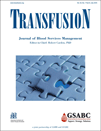Organization and management of an accredited specialist in blood bank (SBB) technology program
Authorship contribution: KMB wrote the manuscript. SLS contributed to writing and verified information. WAF initiated the idea for the manuscript and contributed to writing.
Statement of disclaimer: The views expressed do not necessarily represent the view of the National Institutes of Health, the Department of Health and Human Services, or the U.S. Federal Government.
Abstract
BACKGROUND: Specialists in blood bank (SBBs) technology play important roles in blood banks, transfusion services, regulatory agencies, educational institutions, and other facilities where expertise in blood banking, transfusion medicine, cellular therapy, and tissue transplantation is required.
STUDY DESIGN: Review of pathways that qualify applicants for a national examination administered by the American Society of Clinical Pathology (ASCP) to become a certified specialist and outcomes of accredited programs. Description of a face-to-face, accredited program including review of management topics included in curriculum.
RESULTS: The first examination was administered in 1954. As of December 2009, the total number of certified SBBs was 5124. There are currently 16 accredited SBB programs in the United States. The programs vary in mode of delivery, length of program, number of students accepted, and organization of program officials and faculty, but all must follow specific standards and guidelines in order to be accredited.
CONCLUSION: Students who successfully complete SBB programs have a higher passing rate than those who attempt the certification examination and have not participated in a program. Students can choose among a variety of programs that differ widely in the way they are managed. The role of management in an SBB program ranges from attracting and retaining individuals and maintaining an accredited program to finally graduating individuals who not only pass the certification examination but who also confidently contribute to the field.




